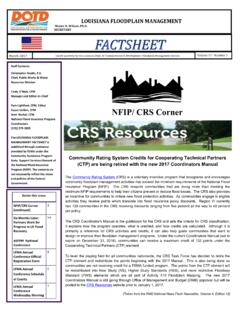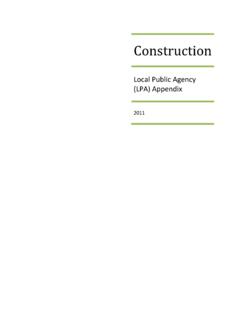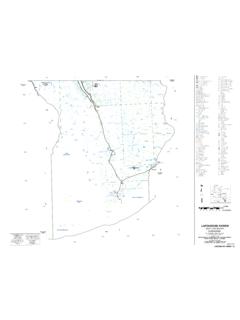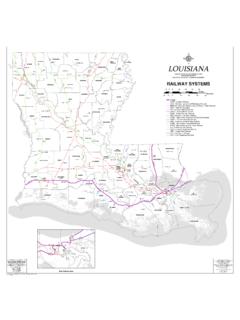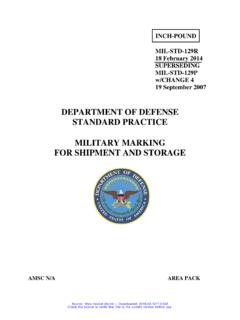Transcription of Chapter 8 - Runway and Taxiway Marking - Louisiana
1 Revised April 2007 Chapter 13 Runway And Taxiway Marking Chapter 13 - Runway And Taxiway Marking Introduction Correctly Marking the paved surfaces of an airport is fundamental in operating an airport safely and effectively. Making sure these markings stay visible is equally as important. The Federal Aviation Administration s (FAA) Advisory Circular AC 150/5340-1J Standards for Airport Markings describe the standards for paved area Marking used on airports. This Chapter will provide information on Marking paved runways, taxiways, and closed or hazardous areas. The FAA s Advisory Circular AC 150/5340-1J Standards for Airport Markings , which includes the figures and diagrams, is attached on the enclosed CD for reference. Runways Runways are defined rectangular surfaces, on an airport, prepared or suitable for the landing or takeoff of airplanes.
2 The colors of markings on runways are white. A Runway should be marked according to its usage. The three classifications of runways are Visual Runways, Nonprecision Instrument Runways, and Precision Instrument Runways. A Visual Runway does not have an existing or planned straight-in instrument approach procedure. A Nonprecision Instrument Runway has an existing instrument approach procedure which uses navigational aids with only horizontal or lateral guidance to the airport or Runway . A Precision Instrument Runway has an existing instrument approach procedure using a precision instrument landing system, which provides both lateral and vertical guidance to a Runway end. Marking Precedence Where multiple runways intersect, the markings on the Runway of the higher classification continue through the intersection, while the markings of the lower classification are interrupted.
3 The one exception is that the Runway threshold Marking , designation, Marking , and touchdown zone markings are relocated along the lower classification Runway to avoid the intersection area. For intersections of runways of the same classification, the preferred Runway (lowest approach minimums or most often used) is considered to be of a higher precedence order. For Marking purposes, the classifications, in descending order is as follows: 1. Precision instrument Runway , Category III 2. Precision instrument Runway , Category II 3. Precision instrument Runway , Category I 4. Non-precision instrument Runway 5. Visual Runway Runway Designation Marking Runways are identified by the white numbers painted on the end of each Runway . These numbers also represent the Runway centerline s compass heading to the nearest 10-degree increment.
4 The Runway centerline s compass heading is measured clockwise from the magnetic north when viewed from the direction of approach. For example, where the compass heading of Louisiana Airport Managers Handbook 13 - 1 Revised April 2007 Chapter 13 Runway And Taxiway Marking a Runway is 174 degrees, the Runway designation would be 17 ; and for a compass heading of 87 degrees, the Runway designation would be 9 (rounded up). For a compass heading ending in 5 , such as 185, the Runway designation Marking could either be 18 or 19. A single-digit Runway designation number should not be preceded by a zero. For parallel runways, the Runway designation will have the same number but they must be followed by L or R designating the left or right position of the runways when viewed from the direction of the approach. The size of the painted Runway designation numbers should be 60 feet tall and 20 feet wide.
5 Runway Centerline Markings Centerline markings on runways identify the physical center of the Runway and provides alignment guidance during landing and takeoff. The Runway centerline markings are white and are located along the centerline of the Runway between the Runway designation markings. These markings consist of a line of uniformly spaced stripes and gaps. The stripes are 120 feet long and have gaps that are 80 feet in length. Any adjustments to the length and gaps of the stripes that may be needed because of Runway length are to be made near the Runway midpoint. The minimum width of each stripe is 12 inches for visual approach runways, 18 inches for nonprecision instrument runways, and 36 inches for precision instrument runways. Runway Threshold Marking A threshold Marking identifies the beginning of the Runway that is available and suitable for landing.
6 The Runway threshold markings consist of eight white longitudinal stripes of uniform dimension arranged evenly about the Runway centerline. These markings start 20 feet from the Runway threshold. The stripes must be 150 feet long, feet wide, and spaced feet apart except the center space which is feet apart. The stripes extend sideways to within 10 feet from the edge of the Runway or to a distance of 90 feet on either side of a Runway centerline, whichever is the smaller lateral distance. (See table next page.) Runway WIDTH NUMBER OF STRIPES 60 feet 4 75 feet 6 100 feet 8 150 feet 12 200 feet 16 Runway Aiming Point Marking An aiming point Marking provides jet aircraft a visual aiming point for landing operations. The aiming points are white and the beginning of these markings are located 1,020 feet from the threshold.
7 The aiming points consist of two rectangular markings, 150 feet in length, located on each side of the Runway centerline. The width of each Marking is 30 feet for a Runway with a width of 150 feet or greater. The spacing between the inner sides of the markings is 72 feet for a Runway width of 150 feet or greater. For runways that are less than 150 feet wide, the width of the markings and the space between the inner sides of the markings is decreased in proportion to Louisiana Airport Managers Handbook 13 - 2 Revised April 2007 Chapter 13 Runway And Taxiway Marking the decrease in the width of the Runway . Where there are touchdown zone markings, the space between the inner sides of the markings should be the same as that of the touchdown markings. Runway Touchdown Zone Marking The touchdown zone markings identify the touchdown zone for landings and are coded to provide distance information.
8 These markings are white and consist of groups of one, two, and three rectangular bars evenly arranged in pairs along the Runway centerline. For runways less than 150 feet in width, the markings and spaces are reduced proportionally, but the lengths remain the same. On runways having touchdown zone markings at both ends, the pairs of markings which extend to within 900 feet of the Runway midpoint are eliminated. The fixed distance markings are a part of the touchdown zone markings but are used alone on nonprecision instrument runways and visual runways 4,000 feet in length or longer used by jet aircraft. Touchdown zone markings are required on runways with precision instrument approaches. Runway Side Strip Marking Runway side stripe markings provide a visual distinction between the Runway and the surrounding terrain and also outline the Runway width.
9 Runway side stripes are white and consist of continuous stripes located along each side of the Runway . The maximum distance between the outer edges of the stripes is 200 feet. The stripes have a minimum width of 36 inches for precision instrument runways and are at least equal to the width of the Runway centerline stripes on other runways. The stripes extend to the end of displaced threshold areas which are used for takeoffs and rollouts. Side stripes are required on precision instrument runways. Runway Threshold Bar A threshold bar identifies the beginning of the Runway that is available for landing when there is pavement aligned with the Runway on the approach side of the threshold. A threshold bar is white and is located on the landing Runway at the threshold.
10 The threshold bar is 10 feet wide and extends across the width of the Runway . Demarcation Bar A demarcation bar identifies a Runway with a displaced threshold from a blast pad, stopway or Taxiway that precedes the Runway . The demarcation bar is yellow and is located on the blast pad, stopway or Taxiway at the point where the Runway intersects. The demarcation bar is 3 feet wide and extends across the width of the blast pad, stopway or Taxiway . Arrows And Arrowheads Arrows are used to identify a displaced threshold area and are useful for centerline guidance for takeoffs and/or rollouts. Arrowheads are used in connection with a threshold bar to highlight the beginning of a Runway where the use of chevrons is not appropriate. Arrows and arrowheads used in a displaced threshold area are white. Arrowheads used on Taxiway prior to a Runway threshold are yellow.

